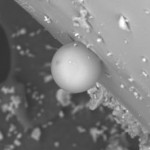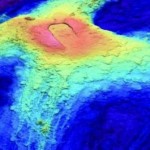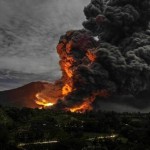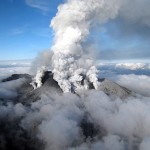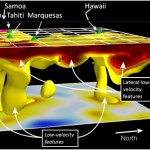We typically think of volcanoes as destructive, but their eruptions could be feeding tiny photosynthetic organisms that live in the ocean.
Primary productivity (how much photosynthesis occurs) in certain areas of the ocean is iron-limited: even though phytoplankton (photosynthetic microscopic organisms) have plenty of all the other nutrients they need, a shortage of iron limits their growth.
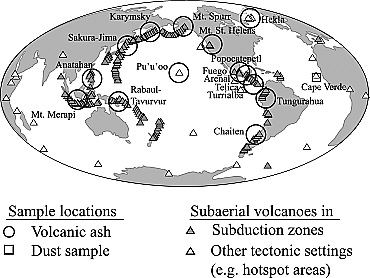 Located in the subarctic and eastern equatorial Pacific and Southern Ocean, these iron-limited regions rely in part on windblown mineral dust to supply iron. But one study suggests that phytoplankton could have another source of iron: volcanoes! When volcanoes erupt, they release ash that contains iron. The Pacific Ocean in particular is surrounded by thousands of volcanoes (the Ring of Fire), 50-60 of which erupt regularly.
Located in the subarctic and eastern equatorial Pacific and Southern Ocean, these iron-limited regions rely in part on windblown mineral dust to supply iron. But one study suggests that phytoplankton could have another source of iron: volcanoes! When volcanoes erupt, they release ash that contains iron. The Pacific Ocean in particular is surrounded by thousands of volcanoes (the Ring of Fire), 50-60 of which erupt regularly.
To estimate how much iron volcanic ash could deliver to the ocean, scientists collected 44 samples of volcanic ash from a variety of locations (one sample was 150 years old!) and dissolved them in seawater to measure how much iron they released. Based on the amount and solubility of iron in the samples, they found that volcanoes could deposit as much iron as windblown dust.
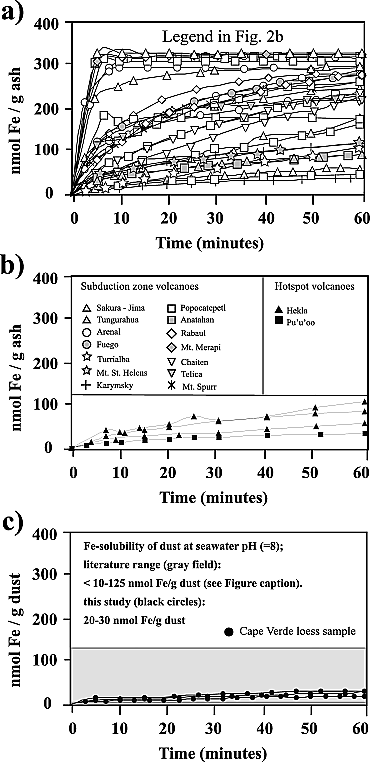 They calculated that over one thousand years, volcanoes send an average of 130–220 × 1015 grams of ash into the Pacific, compared to 40–520 × 1015 grams of mineral dust; factoring in solubility, this amounts to 3-75 × 109 mol Fe from volcanic ash and 1-65 × 109 mol Fe per thousand years. But it's worth noting that a single supereruption (which happen less than once every 10,000 years) can deliver 1018 grams of ash in a single week -- three orders of magnitude larger than the mass deposited by all eruptions in during an average thousand years!
They calculated that over one thousand years, volcanoes send an average of 130–220 × 1015 grams of ash into the Pacific, compared to 40–520 × 1015 grams of mineral dust; factoring in solubility, this amounts to 3-75 × 109 mol Fe from volcanic ash and 1-65 × 109 mol Fe per thousand years. But it's worth noting that a single supereruption (which happen less than once every 10,000 years) can deliver 1018 grams of ash in a single week -- three orders of magnitude larger than the mass deposited by all eruptions in during an average thousand years!
More studies are needed to pinpoint the impact that volcanoes could have on primary productivity in the ocean. Even though the ash could provide iron, ash entering the atmosphere can block sunlight, which would decrease photosynthesis. And while the iron in volcanic ash could increase oxygen production by helping phytoplankton in iron-limited regions, the beneficial effect is greatly outweighed by the voluminous sulfuric and carbon dioxide gases that volcanoes spew during eruptions.
Olgun, N., Duggen, S., Croot, P. L., Delmelle, P., Dietze, H., Schacht, U., ... & Garbe‐Schönberg, D. (2011). Surface ocean iron fertilization: The role of airborne volcanic ash from subduction zone and hot spot volcanoes and related iron fluxes into the Pacific Ocean. Global Biogeochemical Cycles, 25(4). Available online from: http://onlinelibrary.wiley.com/enhanced/doi/10.1029/2009GB003761/?isReportingDone=true

